This post contains affiliate links. Please see our disclosure policy.
This Homemade Vegetable Stock is easy to make, nutritious, and so much better than store-bought! Make it with vegetable scraps to minimize waste, or use fresh vegetables — both make delicious homemade broth, perfect for soups, stews, and savory recipes.
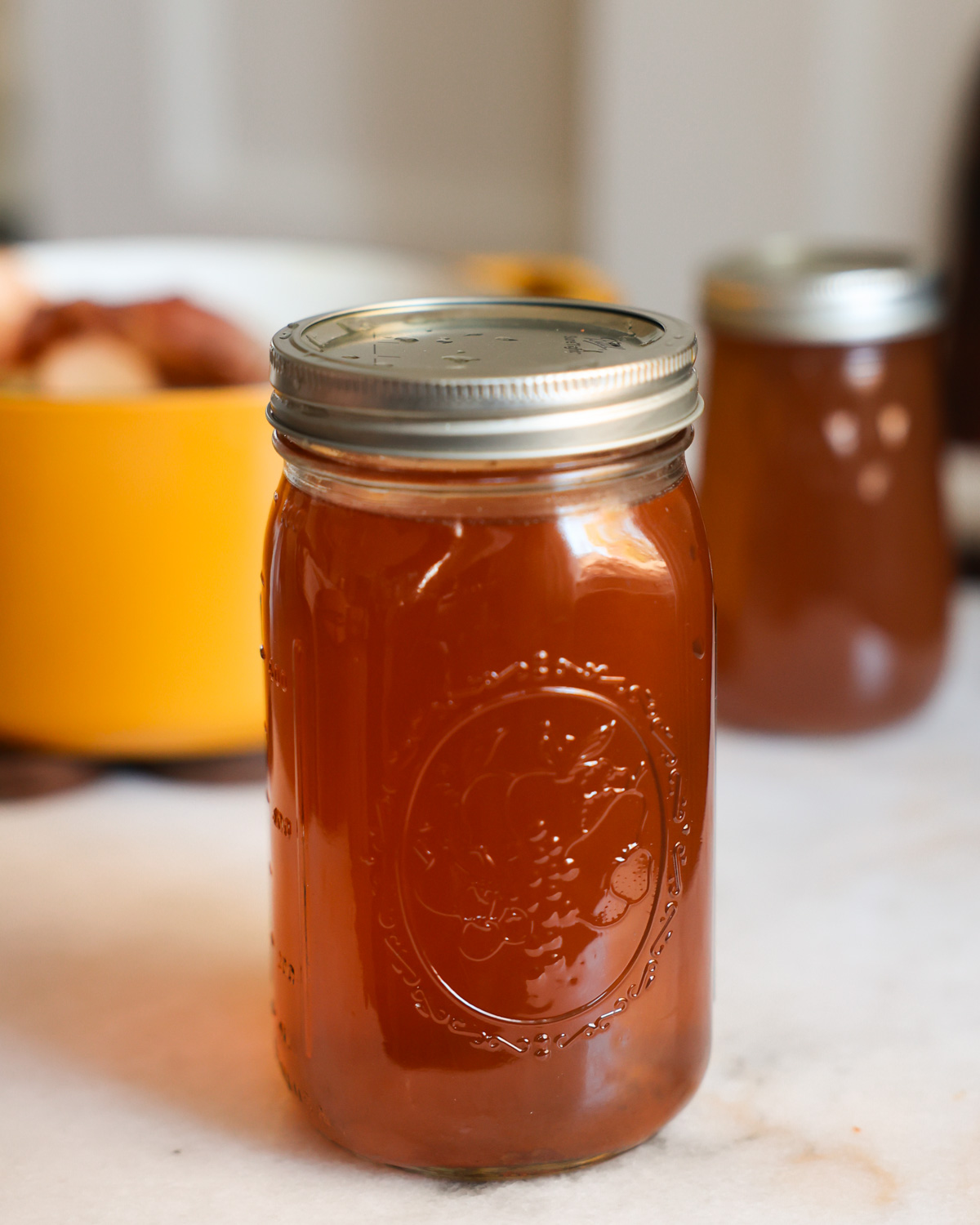
If you haven’t been making homemade vegetable stock or broth, now is the time to start! There’s so much to love about it: it’s easy, nutritious, practically free (if using food scraps), and worlds better than store-bought.
Even though we compost, I always look for new and exciting ways to utilize my food scraps. This recipe is one of my go-to ways to give them a second life! I keep a food storage container in my freezer and add scraps as I cook throughout the week. When that container gets full, I make stock with it. It’s really that simple! Boil, strain, and done.
For those times that we want or need stock but don’t have scraps, I’ve also included directions for making vegetable stock with fresh veggies. Double the recipe and freeze the extra to enjoy later, or see my recipe variations section to make this recipe your own!
Looking for more ways to utilize food scraps? Check out my Carrot Top Pesto and Easy Pear Sorbet recipes!
What Is the Difference Between Broth and Stock?
Traditionally, the biggest difference between broth and stock is the ingredients used: stock is made with bones, and broth is made with meat (or flesh). In both situations, the ingredients are simmered with vegetables and aromatic ingredients. Stock is usually simmered longer and not seasoned with salt, whereas broth is usually made with salt and black pepper.
Because this recipe is plant-based, no bones or meat are added. The biggest defining factor is that it is unseasoned and simmered for 30 minutes, making it a stock! I’m not one to split hairs about small differences like this, however (and it’s super simple just to add some salt!), so you’ll see me referring to this recipe as both. 🙂
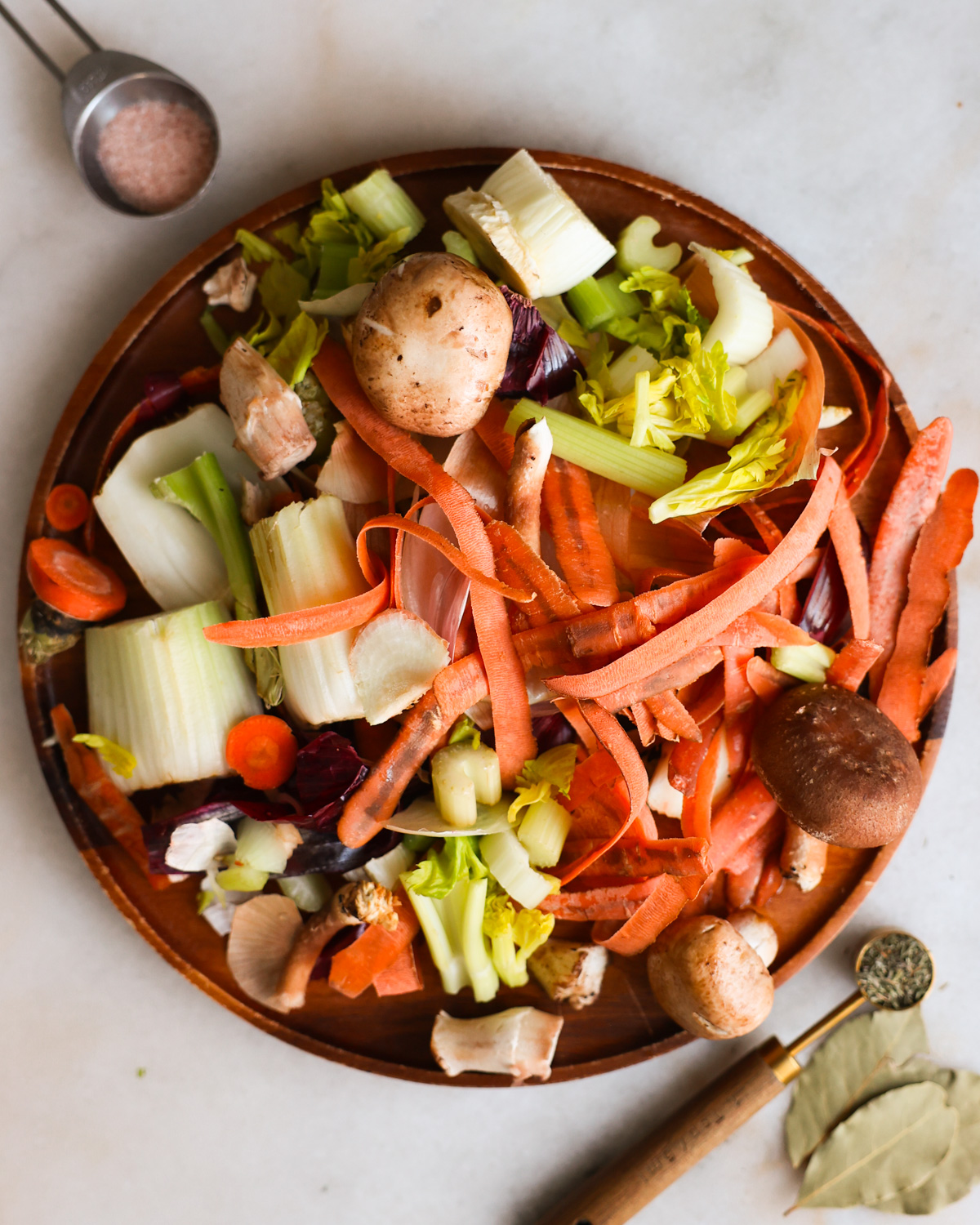
Ingredients
Vegetable Scraps: The star of this vegetable broth recipe! You can use up any combination of cleaned, non-starchy vegetable food scraps, such as those from carrots, celery, onions, leeks, herbs, garlic, green onions, tomatoes, greens, and mushrooms. Be sure not to use starchy vegetables; they are unsuitable for broth!
Bay Leaves: Dried leaves are simmered with the homemade veggie broth, adding light herbaceous flavor. If you have them, you can also use fresh bay leaves.
Dried Thyme: This adds a light herbal note to the homemade vegetable stock, making it worlds above store-bought. If needed, you can substitute dried sage leaves or rosemary.
Water: For the purest veggie broth, use fresh filtered water.
Using Fresh Vegetables
You can also make this vegetable stock recipe with fresh vegetables. I recommend 4-6 cups of the following:
- Onions, carrots, and celery
- Crushed garlic cloves
- Shiitake and baby bella mushrooms
- Fresh herbs
- Dried bay leaves (2)
- Chopped leeks or fennel fronds.
How to Make Vegetable Stock
- Combine Ingredients. Combine all the ingredients in a large pot and bring to a boil over high heat.

- Simmer. Reduce the heat to low or medium-low and bring to a simmer. Cover the pot and cook for 30 minutes.
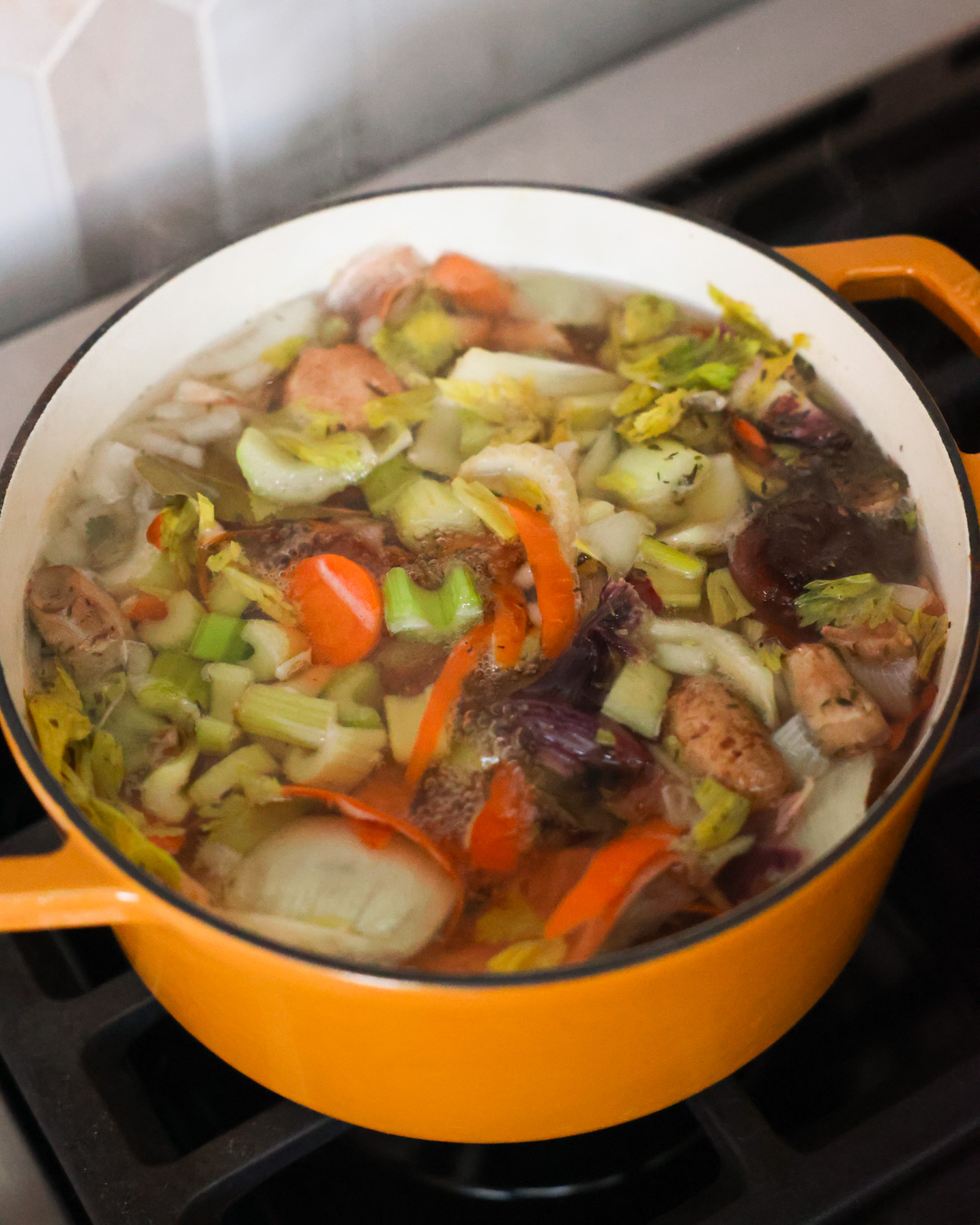
- Strain. Carefully strain the broth through a wire mesh strainer or cheesecloth.
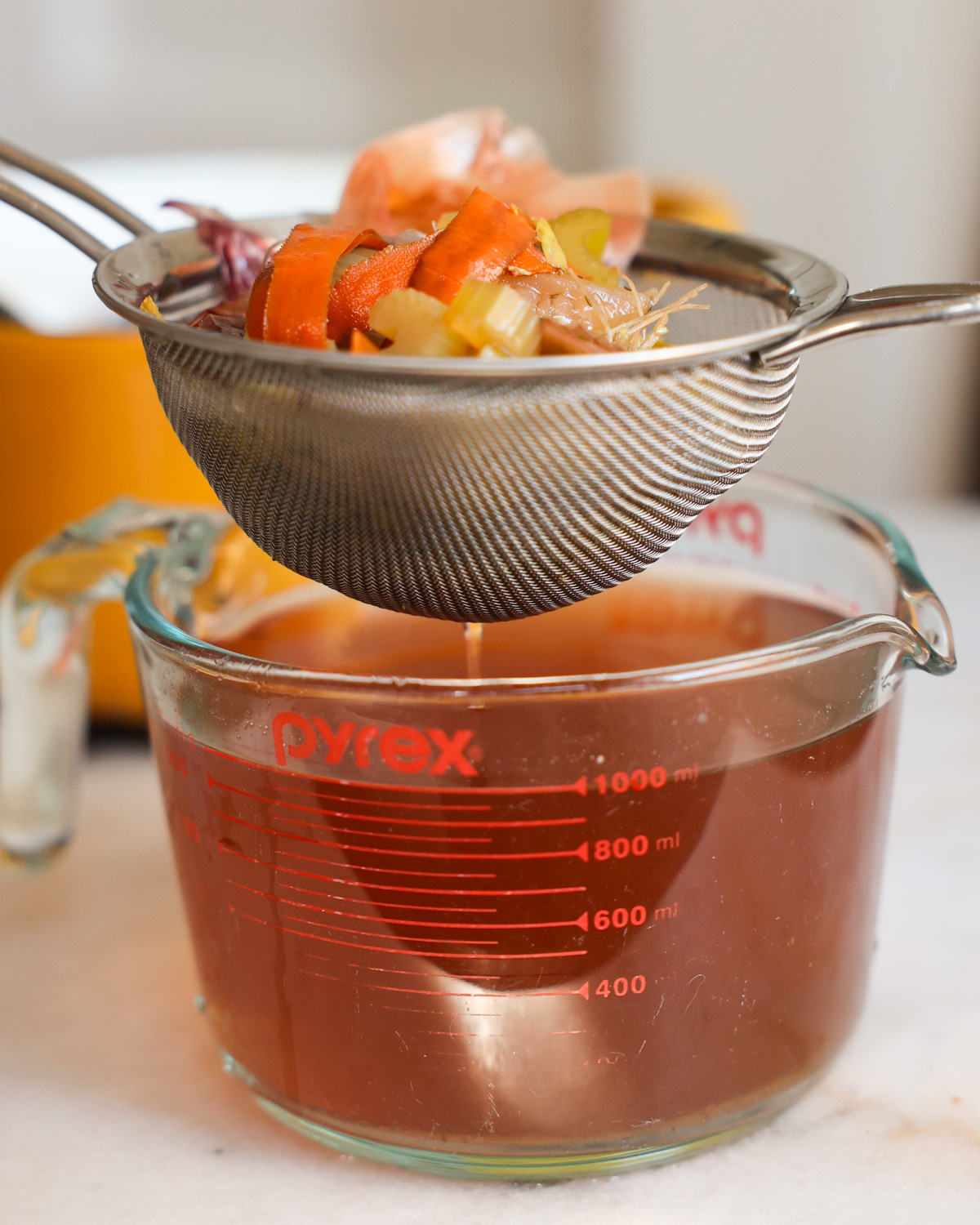
- Cool and Store. Cool the vegetable stock in the pot or a heat-safe shallow mixing bowl before storing it in glass containers.

Recipe Pro-Tips
- Do not use starchy vegetable scraps. The starch in vegetables such as sweet or white potatoes, parsnips, or peas will release into the broth, making it cloudy or thickening it.
- Drain well. For clear, filtered vegetable broth, drain the cooked veggie mixture over a fine mesh strainer. If your veggie scraps are small, line the strainer with cheesecloth to catch the pieces.
- Season with salt if desired.This veggie stock recipe is not salted to keep it true to form, but you can season it with 1-2 teaspoons of fine sea salt if preferred.
How to Store Veggie Scraps
Fresh veggie scraps keep in ventilated produce bags in the refrigerator for 1-2 days. For longer storage, freeze them in a freezer-safe container for up to 3 months.
If making this veggie broth recipe with frozen scraps, you can add them to the pot straight from the freezer. They do not need to be defrosted first.
Flavor Boosters & Recipe Variations
Adjust your batch to food scraps or seasonings you have on hand or flavor preferences with any of the following variations:
- Flavor Boosters: Add a few teaspoons of nutritional yeast for savory, cheesy notes. For deep tomato flavor, add tomato paste or sun-dried tomatoes. You can also simmer a few tablespoons of soy sauce or tamari with the vegetables for a touch of salt and umami.
- Mushrooms: Make the most of nutrient-dense, but sometimes expensive food by mixing up to 2 cups of mushroom stems and pieces with the vegetable scraps.
- Herbs: Swap dried rosemary, sage leaves, Herbes de Provence, Italian seasoning, poultry seasoning, or a combination of the above.
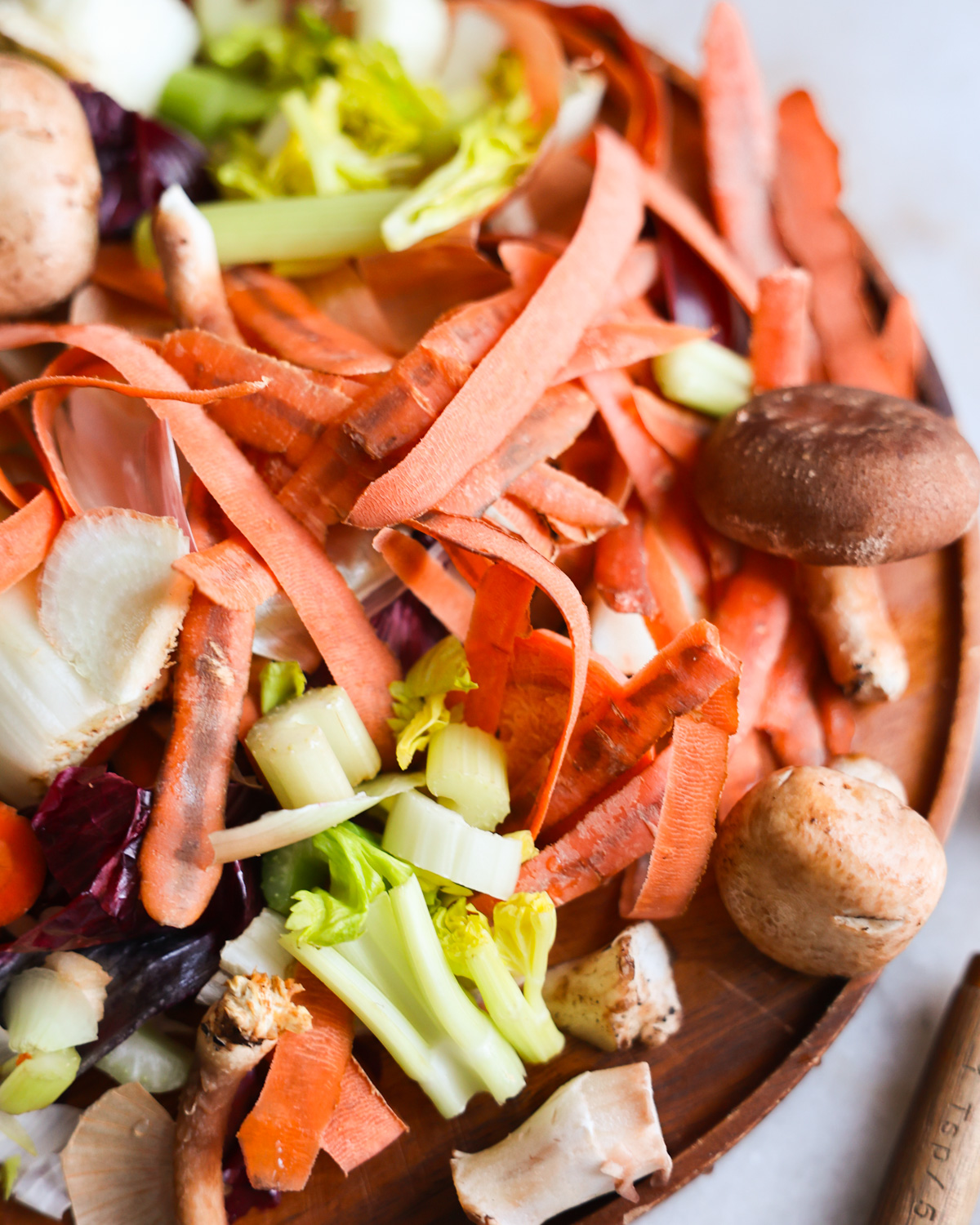
Storage Directions
- Refrigeration: Cool the broth completely to room temperature before transferring it to glass containers and refrigerating it for up to 7 days.
- Freezing: The broth can also be frozen in a freezer-safe container or zip-top bag for up to 6 months. Defrost it in a large bowl overnight in the refrigerator or over low heat on the stovetop.
- Reheating: Warm it in the microwave or on the stovetop over medium heat until hot.
Frequently Asked Questions
You can put nearly any vegetable, herb, or aromatic ingredient into vegetable broth except starchy ones. Sweet and white potatoes, parsnips, yucca root, peas, and plantains should not be used to make it.
There are many ways to add flavor to veggie stock recipes, such as adding fresh or dried herbs, fresh garlic cloves, tomato paste, sea salt, peppercorns, and bay leaves.
When making it with vegetable scraps, it is much cheaper to make vegetable broth than to purchase it! It is also more sustainable and better for the environment.
Cozy Vegan Soup Recipes
Once you’ve made this delicious homemade vegetable broth, enjoy it in any of the following soup recipes!
- Curried Parsnip Soup
- Kabocha Squash Soup
- Vegan Lentil Soup
- Instant Pot Black Bean Soup
- Vegan Butternut Squash Soup
Save now, cook later.

Vegetable Stock
Video
Ingredients
- 4-6 cups vegetable scraps, From clean, non-starchy vegetables like carrots, celery, onions, leeks, herbs, garlic, green onions, tomatoes, mushrooms and mushroom bottoms, and greens
- 1-2 dried bay leaves
- 1-2 tsp dried thyme
- 8-10 cups water
Instructions
- Combine all the ingredients in a large pot and bring to a boil over high heat.
- Reduce the heat to low or medium-low and bring to a simmer. Cover the pot and cook for 30 minutes.
- Carefully strain the broth through a wire mesh strainer or cheesecloth. Cool the vegetable stock in the pot or a heat-safe shallow mixing bowl before storing in glass containers.
Notes
- Refrigeration: Cool the broth completely to room temperature before transferring it to glass containers and refrigerating it for up to 7 days.
- Freezing: The broth can also be frozen in a freezer-safe container or zip-top bag for up to 6 months. Defrost it in a large bowl overnight in the refrigerator or over low heat on the stovetop.
- Reheating: Warm it in the microwave or on the stovetop over medium heat until hot.
- Using fresh vegetables. You can also make this vegetable stock recipe with fresh vegetables. I recommend 4-6 cups of cleaned and chopped onions, carrots, and celery; 3-4 peeled and crushed garlic cloves, a handful of fresh herbs, 2 dried bay leaves, and chopped leeks or fennel fronds.
- Do not use starchy vegetable scraps. The starch in vegetables such as sweet or white potatoes, parsnips, or peas will release into the broth, making it cloudy or thickening it.
- Drain well. For clear, filtered vegetable broth, drain the cooked veggie mixture over a fine mesh strainer. If your veggie scraps are small, line the strainer with cheesecloth to catch the pieces.
- Season with salt if desired. This veggie stock recipe is not salted, but you can season it with 1-2 teaspoons of fine sea salt if preferred.
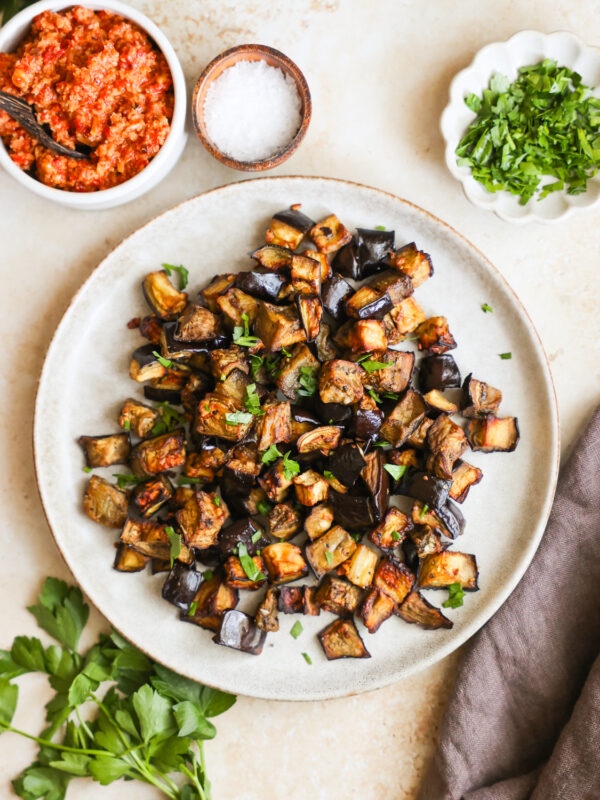









1 Comment